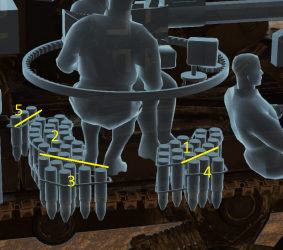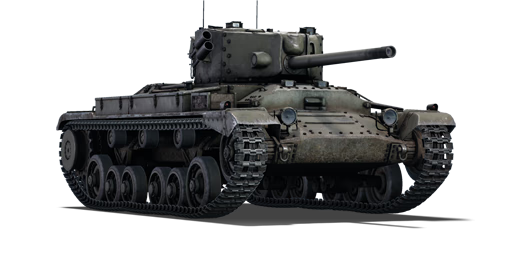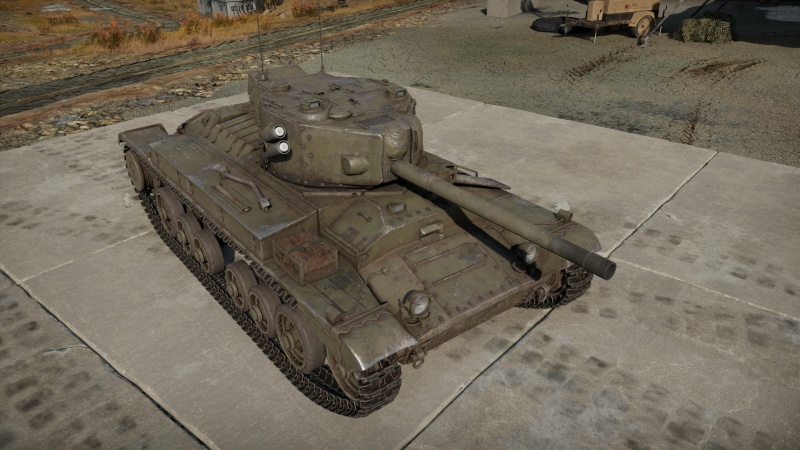Valentine IX
Contents
Description
The Tank, Infantry, Valentine IX is a rank II British medium tank with a battle rating of 3.0 (AB/RB/SB). It was introduced along with the initial British tree line in Update 1.55 "Royal Armour".
The general style of play that best works with the Valentine IX changes depending on the battle ratings of the current match. If you find yourself at the higher end of the spectrum, the armour is still very viable and you can play much like a standard heavy tank. If you find yourself on the lower end of the spectrum your armour is of less value, and many tanks will be able to penetrate you reliably, this often means its best to play in a supporting role of other tanks. Unlike the Valentine I, the Valentine IX can engage most other tanks somewhat reliably at longer ranges and with more reliability due to being significantly up gunned from the former model.
General info
Survivability and armour
Armour type:
- Rolled homogeneous armour
- Cast homogeneous armour (Gun mantlet)
| Armour | Front | Sides | Rear | Roof |
|---|---|---|---|---|
| Hull | 60 mm (1°) Front plate 30 mm (65-67°) Front glacis 20 mm (73°), 60 mm (24°) Lower glacis |
50 mm | 17 mm (58-59°) Top 20 mm (65°), 60 mm (1°) Bottom |
20 mm |
| Turret | 65 mm (0-66°) Turret front 65 mm (0-62°) Gun mantlet |
60 mm | 65 mm (1-57°) | 20 mm |
Note:
- Suspension wheels, bogies, and tracks are 20 mm thick.
- Belly armour is 20 mm thick.
Mobility
| Game Mode | Max Speed (km/h) | Weight (tons) | Engine power (horsepower) | Power-to-weight ratio (hp/ton) | |||
|---|---|---|---|---|---|---|---|
| Forward | Reverse | Stock | Upgraded | Stock | Upgraded | ||
| Arcade | 27 | 4 | 17.3 | 256 | 315 | 14.8 | 18.21 |
| Realistic | 25 | 3 | 146 | 165 | 8.44 | 9.54 | |
Modifications and economy
Armaments
Main armament
| 57 mm 6pdr OQF Mk.III | Turret rotation speed (°/s) | Reloading rate (seconds) | |||||||||||
|---|---|---|---|---|---|---|---|---|---|---|---|---|---|
| Mode | Capacity | Vertical | Horizontal | Stabilizer | Stock | Upgraded | Full | Expert | Aced | Stock | Full | Expert | Aced |
| Arcade | 53 | -12°/+20° | ±180° | N/A | 15.23 | 21.08 | 25.60 | 28.31 | 30.12 | 5.20 | 4.60 | 4.24 | 4.00 |
| Realistic | 9.52 | 11.20 | 13.60 | 15.04 | 16.00 | ||||||||
Ammunition
| Penetration statistics | |||||||
|---|---|---|---|---|---|---|---|
| Ammunition | Type of warhead |
Penetration @ 0° Angle of Attack (mm) | |||||
| 10 m | 100 m | 500 m | 1,000 m | 1,500 m | 2,000 m | ||
| Shot Mk.5 | AP | 101 | 97 | 82 | 66 | 53 | 43 |
| Shot Mk.5 HV | AP | 108 | 104 | 87 | 70 | 57 | 46 |
| Shot Mk.8 | APC | 110 | 106 | 89 | 72 | 59 | 48 |
| Shot Mk.9 | APCBC | 122 | 118 | 101 | 84 | 70 | 58 |
| Shell Mk.10 | HE | 9 | 9 | 9 | 9 | 9 | 9 |
| Shell details | |||||||||
|---|---|---|---|---|---|---|---|---|---|
| Ammunition | Type of warhead |
Velocity (m/s) |
Projectile Mass (kg) |
Fuse delay (m) |
Fuse sensitivity (mm) |
Explosive Mass (TNT equivalent) (g) |
Ricochet | ||
| 0% | 50% | 100% | |||||||
| Shot Mk.5 | AP | 815 | 2.8 | N/A | N/A | N/A | 47° | 60° | 65° |
| Shot Mk.5 HV | AP | 853 | 2.8 | N/A | N/A | N/A | 47° | 60° | 65° |
| Shot Mk.8 | APC | 853 | 2.87 | N/A | N/A | N/A | 48° | 63° | 71° |
| Shot Mk.9 | APCBC | 801 | 3.23 | N/A | N/A | N/A | 48° | 63° | 71° |
| Shell Mk.10 | HE | 655 | 2.72 | 0 | 0.1 | 590 | 79° | 80° | 81° |
Ammo racks

| Full ammo |
1st rack empty |
2nd rack empty |
3rd rack empty |
4th rack empty |
5th rack empty |
Visual discrepancy |
|---|---|---|---|---|---|---|
| 53 | 43 (+10) | 32 (+21) | 21 (+32) | 11 (+42) | 1 (+52) | No |
Optics
| Valentine IX Optics | ||
|---|---|---|
| Which ones | Default magnification | Maximum magnification |
| Main Gun optics | x1.85 | x3.5 |
| Comparable optics | M4A1 | |
Usage in battles
Overview:
The Valentine IX is an interesting vehicle. The armour can be useful against most enemy cannons if you angle properly, but the mobility is sub par. The 6 pounder gun provides excellent penetration with a fast velocity, not to mention the reload rate and semi stabilization. The best way to play the Valentine IX is to play around cover and play carefully. The benefit of being slow is it gives Valentine commanders time to think before they act. The Valentine will be the last to the fight in most situations, so make sure to pay attention to your allies and enemy positions as they reveal themselves. With careful planning, the Valentine can preform very well. Because it is so slow, it is important to play with your team. Use the map to point out enemy positions and pay attention when your allies do the same. Also be careful not to push too far into enemy territory, your low speed will not let you get out quickly. You cannot rely on smoke cover for retreats either as you only get 2 smoke grenades that are launched together, which is far fewer than most British vehicles. Another weakness to consider with the Valentine IX specifically is the lack of a machine gun. While the MGs on most tanks are not often used, lacking one is still a disadvantage.
Notable Enemies:
The most notable enemies for the Valentine IX are the Panzer IV F2, and any T-34. The Panzer IV F2 will make short work of the Valentine, regardless of armour angling. The T-34 is very difficult to kill in the Valentine because the 6 pounder gun struggles against angled armour. Against the T-34, shoot for the turret or machine gun port. Against the Panzer IV F2, just make sure you shoot first.
Differences AB vs RB:
While the slow speed can be an advantage in RB, allowing Valentine commanders to play more cautiously, it AB it is a simple disadvantage. However the other qualities of the Valentine allow it to be a somewhat competitive front line medium tank in AB, using its angled armour and firepower to bounce a few shots and easily dispatch most enemy vehicles.
Pros and cons
Pros:
- 57 mm gun has decent penetration
- Upper glacis is sloped, can bounce a few shots
- Low profile allows it to hide behind obstacles
- Decent stock shells
- Turret is angled and can bounce some shots
- Fast reload speed
Cons:
- No machine gun
- Hull armour is unchanged from Valentine I, much less effective now due to increased BR.
- Slow top speed (22 km/h)
- Slow traverse speed, easily flanked
- Driver's port and the area around it is a major weak spot
- No explosive filler in shells
- Only 3 crew members (crew can be knocked out very easily)
- Thin top armour makes it vulnerable to air attacks
- Unlike many other British tanks, very few smoke grenades and all are released at once.
History
Development
The experiences taken from the development of the A9, A10 cruiser tanks and the A11 infantry tank prompted Vickers-Armstrongs to begin development of a new tank. As a private venture, the design did not receive any designations from the British General Staff during its creation. The designing of the tank focused on the tank having the weight of a cruiser, but with the armour comparable to the infantry tanks. The basis was to have the vehicle with 60 mm of frontal armour and a 2-pounder gun in a two-man turret. To make it as light as possible, it was small and featured a cramped interior. The design used features taken from the A9 and A10 tanks so the design was easier to produce and cheaper to make. Vickers unveiled the design to War Office at February 10, 1938. While they initially viewed it unfavorably for its tiny two-man turret, they took it in April 1939 due to the growing tense situation in Europe with Nazi Germany, with the first order coming in May 1940 after the losses suffered by the British Expeditionary Forces in the Battle of France. The name Valentine was given to the tank sometime between its introduction to War Office and its adoption. The origin of the name is disputed, some say it was due to its introduction on February 14 in 1938 or 1940, other say it was the middle name of Sir John V. Carden, who helped design the Valentine's predecessors. Other sources say it is a name from the Vickers' company full name (Vickers-Armstrong Ltd Elswick & [Newcastle-upon] Tyne), and David Fletcher from Bovington Tank Museum say that "Valentine" was a code name used by the company for its development.
The Valentine was put into service as quickly as possible under the designation Tank, Infantry, Mk.III. Vickers, Metropolitan-Cammell Carriage & Wagon, and Birmingham Railway Carriage & Wagon Company were all involved in the construction of this vehicle. During World War II, Canada was also contracted to build the Valentine to build up their own tank forces. The United Kingdom produced a total of 6,855 Valentines during the war between the three company while Canada built 1,420 Valentine tanks in their factories, for a total of 8,275 tanks produced, making the Valentine the most produced British tank in the entire war.
Variants
The Valentine is one of the most modified British tank in World War II, up to eleven variants were made during its entire production life.
- Mark I: The first one, it was built with a rivet construction, a 135 hp petrol engine, and a 2-pounder, but was not sent to combat due to mechanical problems.
- Mark II: Uses a 131 hp diesel engine and has an auxiliary fuel tank added to the left hull.
- Mark III: Has a slightly thinner side armour (60 mm to 50 mm) and a modified turret design, giving room for a loader in the tank, freeing the commander to do his job.
- Mark IV A modified Mk.II using an American 138 hp GMC diesel engine and an American-produced transmission, making the tank more reliable.
- Mark V: The same as Mk.IV, except using the Mk.III as the basis.
- Mark VI: A Canadian built Valentine, using Canadian and American parts and a GMC diesel engine, plus later switching the BESA machine gun into a Browning machine gun.
- Mark VII: A Canadian Mk.VI with a new radio set and a modified interior. Another Mk.VII named the Mark VIIA has jettisonable fuel tanks and new tracks, oil cooler, and headlights.
- Mark VIII: Uses a British AEC diesel engine and a modified turret to use the 6-pounder. The modification eliminated the coaxial machine gun from the design.
- Mark IX: A Mk.V modified to take the 6-pounder as well, but with an armour reduction. Later version also had a stronger 165 hp GMC diesel engine installed.
- Mark X: Features another modified turret design using the 6-pounder, but made it able to use a coaxial machine gun again and still uses the 165 hp diesel engine. Uses a welded construction
- Mark XI: The Mk.X using the QF 75 mm gun instead of a 6-pounder, with the 210 hp diesel engine. However, these tanks only served as a command tank in the battlefield. Uses a welded construction
Combat usage
The Valentine mostly saw service in the North African Campaign, where the crew reported on it very favorable as a reliable and well-protected tank. The first unit who saw action with the Valentine was the 8th Royal Tank Regiment in Operation Crusader, where it was in the process of replacing the Matilda III. The reliability is expressed when some Valentine were reported to have traveled a distance of 4,800 kilometers by the time the British reached Tunisia. The Valentine tanks soon saw wide-spread use by mid-1941 when they were issued out widely to armoured regiments due to the lack of cruiser tanks available to fill in the ranks.
However, the biggest weakness of the Valentine tank is the lack of high-explosive rounds for the 2-pounder, a weakness suffered by every other tank using the 2-pounder. This and the 2-pounder's growing deficiency against tank armour was remedied by the usage of the 6-pounder on the Valentine after the Mark VIII version, and then the QF 75 mm gun. However, these larger guns were harder to mount on the small Valentine turret and made for a cramped interior, even removing the established loader's position made in an enlarge turret for the 2-pounder. By the time these larger guns were introduced for the tank, better tanks were being introduced, such as the Churchill heavy tanks from Britain and the M4 Shermans from the Americans. Despite the better tanks, the Valentine's low height is able to exploit small cover on the battlefield and take up a good hull-down position behind hills.
Some Valentines were sent to the Soviet Union as part of the Lend-Lease program, most of the Valentines came from Canada's production lines. The Valentines saw use from the time of Battle of Moscow in 1941 all the way until the end of the war, though the Valentines saw use more as a second-line tank due to its relative weakness. It was criticized for its slow speed and weak gun, but was liked for its small size, reliability, and armour protection and thus the Soviet Supreme Command continue asking for it and its production to continue until the end of the war.
By 1944, the Valentine is mostly taken out from the front-line services and replaced by the newer tanks. A few were retained for special purposes and command vehicles for Archer units, which is a tank destroyer based off the Valentine chassis. The tank continue to see use in the Pacific in limited numbers until May 1945 in the 3rd New Zealand Division, some had their armaments changed to the larger 3-inch howitzer to use it stronger high-explosive ammunition against the Japanese. New Zealand kept the normal and modified Valentines all the way until 1955. The last known combat usage of the Valentine was on Cyprus in early 1960s when a turret-less Valentine was used by the Greek militia, added with a make-shift armour and a machine gunner position with a Bren gun.
Survivors
About forty Valentines and vehicles based off the Valentine chassis exist in various conditions in the world. Valentines in running condition exist in the Bovington Tank Museum and in private hands in New Zealand and United Kingdom. The Valentines survivors can be seen in UK, Canada, Belgium, France, Russia, Australia, and New Zealand.
Media
- Skins
- Videos
See also
Links to the articles on the War Thunder Wiki that you think will be useful for the reader, for example:
- reference to the series of the vehicles;
- links to approximate analogues of other nations and research trees.
External links
Paste links to sources and external resources, such as:
- topic on the official game forum;
- other literature.
| Britain medium tanks | |
|---|---|
| Valentine | Valentine I · Valentine IX · Valentine XI |
| Cromwell | Cromwell I · Cromwell V · Cromwell V (RP-3) |
| Cromwell derivatives | Challenger · Avenger · Comet I · Comet I "Iron Duke IV" · Charioteer Mk VII |
| Centurion | Centurion Mk 1 · Centurion Mk.2 · Centurion Mk 3 · Centurion Mk.5 AVRE · Centurion Mk 10 · Centurion Action X · FV4202 |
| Vickers MBT | Vickers Mk.1 · Vickers Mk.3 · Vickers Mk.7 |
| Chieftain | Chieftain Mk 3 · Chieftain Mk 5 · Chieftain Mk 10 |
| Challenger 1 | Challenger Mk.2 · Challenger Mk.3 · Challenger DS |
| Challenger 2 | Challenger 2 · Challenger 2 (2F) · Challenger 2 TES · Challenger 2 OES · Challenger 2E · Challenger 2 Black Night |
| Challenger 3 | Challenger 3 TD |
| Australia | A.C.I · A.C.IV · Centurion Mk.5/1 |
| South Africa | Olifant Mk.1A · Olifant Mk.2 · TTD |
| India | Vijayanta · Bhishma TWMP |
| Israel | ▄Sho't Kal Dalet |
| Jordan | Khalid |
| Sweden | ▄Strv 81 (RB 52) |
| USA | Grant I · Sherman II · Sherman Firefly · Sherman IC "Trzyniec" |





